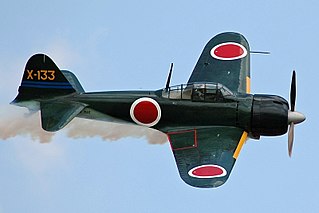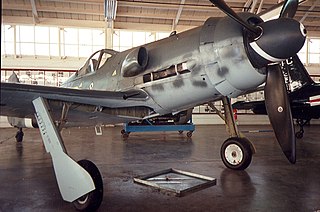
The Mitsubishi A6M "Zero" is a long-range fighter aircraft formerly manufactured by Mitsubishi Aircraft Company, a part of Mitsubishi Heavy Industries, and operated by the Imperial Japanese Navy from 1940 to 1945. The A6M was designated as the Mitsubishi Navy Type 0 carrier fighter, or the Mitsubishi A6M Rei-sen. The A6M was usually referred to by its pilots as the Reisen, "0" being the last digit of the imperial year 2600 (1940) when it entered service with the Imperial Navy. The official Allied reporting name was "Zeke", although the use of the name "Zero" was used colloquially by the Allies as well.

The Kawanishi N1K Kyōfū is an Imperial Japanese Navy floatplane fighter. The Kawanishi N1K-J Shiden was an Imperial Japanese Navy Air Service land-based version of the N1K. Assigned the reporting name "George", the N1K-J was considered by both its pilots and opponents to be one of the finest land-based fighters flown by the Japanese during World War II.

The Kawasaki Ki-61 Hien is a Japanese World War II fighter aircraft used by the Imperial Japanese Army Air Service. The Japanese Army designation was "Army Type 3 Fighter" (三式戦闘機). Allied pilots initially believed Ki-61s were Messerschmitt Bf 109s and later an Italian aircraft, which led to the Allied reporting name of "Tony", assigned by the United States War Department. It was the only mass-produced Japanese fighter of the war to use a liquid-cooled inline V engine. Over 3,000 Ki-61s were produced. Initial prototypes saw action over Yokohama during the Doolittle Raid on 18 April 1942, and continued to fly combat missions throughout the war.

Lieutenant Junior Grade Hiroyoshi Nishizawa was an ace of the Imperial Japanese Navy Air Service during World War II.

Samurai! is a 1957 autobiographical book by Saburo Sakai co-written with Fred Saito and Martin Caidin. It describes the life and career of Saburō Sakai, the Japanese combat aviator who fought against American fighter pilots in the pacific theater of World War II, surviving the war with 64 kills as one of Japan's leading flying aces. Caidin wrote the prose of the book, basing its contents on journalist Fred Saito's extensive interviews with Sakai as well as on Sakai's own memoirs.

Toshio Ōta was a World War II Japanese fighter ace. In early 1942, at the age of 22, he flew a Mitsubishi A6M Zero with the Lae based Tainan Air Group. There the young petty officer, 1st class became one of the so-called "Clean-up Trio" of Japanese aces, along with his squadron mates Saburo Sakai and Hiroyoshi Nishizawa.

Lieutenant Commander Junichi Sasai was a Japanese naval aviator and fighter ace of the Imperial Japanese Navy during World War II. Lieutenant (j.g.) (中尉) Sasai was killed leading his fighter squadron during an attack of Henderson Field during the Battle of Guadalcanal.

James Julien "Pug" Southerland II was a United States Navy fighter pilot during World War II. He was an ace, being credited with five victories, flying Grumman F4F Wildcats. He was awarded the Silver Star, Distinguished Flying Cross twice, and the Purple Heart.

The Champlin Fighter Museum was an aircraft museum located at Mesa, Arizona. It specialized in airworthy World War I and World War II fighters. After 22 years of operation, the Museum was closed on May 26, 2003 and its collection was moved to the Museum of Flight at Seattle's Boeing Field.

Kenji Okabe was an ace fighter pilot in the Imperial Japanese Navy (IJN) during World War II. Participating in many of the Pacific War battles and campaigns as a member of several units, Okabe was officially credited with destroying 15 enemy aircraft. Okabe was credited with shooting down eight enemy aircraft on 8 May 1942 during the Battle of the Coral Sea, the IJN's official record for the number of aircraft destroyed in a single encounter. He is famous for his strong opposition to the kamikaze attacks, rare in IJN at the time. Okabe survived the war.

The Tainan Air Group was a fighter aircraft and airbase garrison unit of the Imperial Japanese Navy (IJN) during the Pacific campaign of World War II. The flying portion of the unit was heavily involved in many of the major campaigns and battles of the first year of the war. The exploits of the unit were widely publicized in the Japanese media at the time, at least in part because the unit spawned more aces than any other fighter unit in the IJN. Several of the unit's aces were among the IJN's top scorers, and included Hiroyoshi Nishizawa, Saburō Sakai, Junichi Sasai, Watari Handa, Masaaki Shimakawa, and Toshio Ōta.

Watari Handa was an officer and ace fighter pilot in the Imperial Japanese Navy (IJN) during the Second Sino-Japanese War and the Pacific theater of World War II. In aerial combat over China and the Pacific, he was officially credited with having destroyed 13 enemy aircraft.

Masaaki Shimakawa was a warrant officer and ace fighter pilot in the Imperial Japanese Navy (IJN) during the Pacific theater of World War II. In aerial combat over the Pacific he was officially credited with destroying eight enemy aircraft with 12 or 13 assists.

Sadaaki Akamatsu was an officer and ace fighter pilot in the Imperial Japanese Navy (IJN) during the Second Sino-Japanese War and the Pacific theater of World War II. In aerial combat over China and the Pacific, he was officially credited with destroying 27 enemy aircraft.
Tobera Airfield was an aerodrome located near Tobera, near Keravat, East New Britain, Papua New Guinea. The airfield was constructed by the Imperial Japanese in World War II during August 1943. Tobera was later neutralized by Allied air bombing from 1944. The airfield was abandoned after the cessation of hostilities.

Kaneyoshi Muto was a Japanese naval aviator and flying ace known for his great skill in fighter aircraft. Fellow ace Saburō Sakai called him "a genius in the air."

USS ABSD-4, later redesignated as AFDB-4, was a nine-section, non-self-propelled, large auxiliary floating drydock of the US Navy. Advance Base Sectional Dock-4 was constructed in sections during 1942 and 1943 by the Mare Island Naval Shipyard in Vallejo, California for World War 2. With all ten sections joined, she was 927 feet long, 28 feet tall, and with an inside clear width of 133 feet 7 inches. ABSD-4 had a traveling 15-ton capacity crane with a 85-foot radius and two or more support barges. The two side walls were folded down under tow to reduce wind resistance and lower the center of gravity. ABSD-4 had 6 capstans for pulling, each rated at 24,000 lbf (110,000 N) at 30 ft/min (0.15 m/s), 4 of the capstans were reversible. There were also 4 ballast compartments in each section.



















